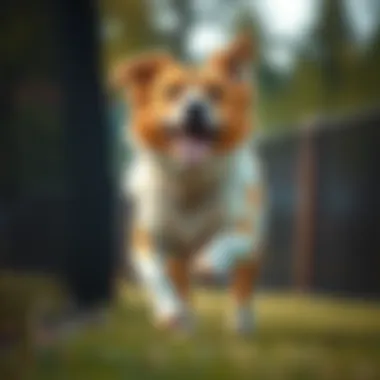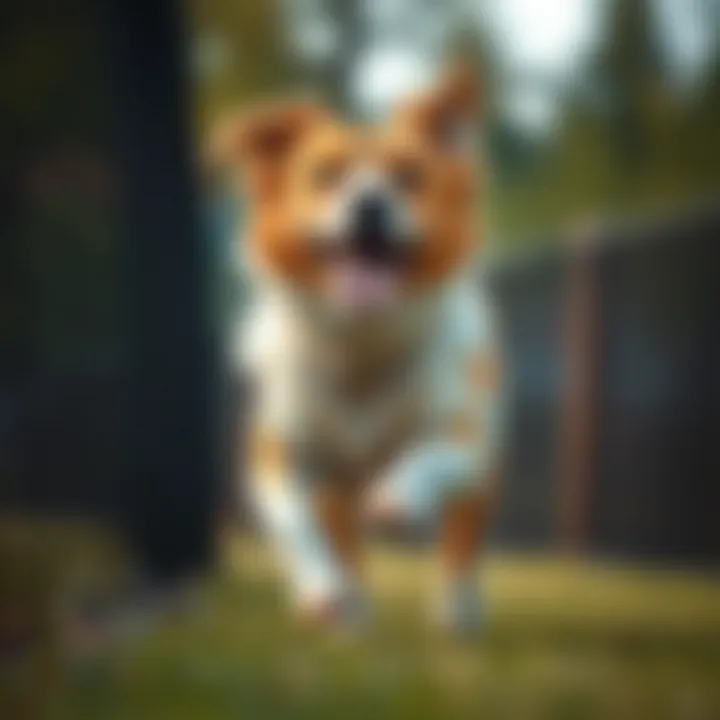Top Wireless Dog Fence Companies Reviewed for Pet Safety


Intro
Wireless dog fences have grown in popularity over the years, providing a practical and effective solution for pet containment. They offer a sense of freedom for your furry friends while ensuring they remain safe within designated boundaries. As a pet owner, it's essential to understand the various offerings from wireless dog fence companies, the technology they incorporate, and how to effectively choose a system that aligns with your needs. The following sections aim to unfold the fundamentals of pet care and explore the nuances of behavior, training, and all aspects necessary for a happy pet within a safe environment.
Pet Care Essentials
When it comes to keeping your pet safe and sound at home, several key components come into play. Beyond just having a wireless fence, understanding the essentials of pet care can provide a more holistic approach to pet ownership.
Daily Nutrition Requirements
Pets require a well-rounded diet to ensure their health and vitality. It's not just about filling their bowls but understanding the nutrients they need. High-quality protein, fats, carbohydrates, vitamins, and minerals should be the cornerstones of their daily food intake. For instance, while many folks instinctively reach for popular brands like Blue Buffalo or Royal Canin, it’s wise to study the specific dietary needs of your dog breed, age, and health status. Always consult your veterinarian for personalized dietary advice.
Exercise and Playtime
A tired dog is a happy dog, as the saying goes. Regular exercise is crucial, and the amount needed often varies by breed and age. A Golden Retriever, for instance, may need an hour of vigorous activity daily, while a French Bulldog might be satisfied with shorter, more engaging play sessions. Activities can include walks, fetch, or even agility training, which can also strengthen the owner-pet bond.
Grooming Tips
Grooming isn’t just about looks; it plays a vital role in your dog’s comfort and health. It’s recommended to brush your dog’s coat regularly to prevent matting, especially for breeds like Maltese or Cocker Spaniels. Don't forget about nail trimming and oral hygiene; both are essential for preventing discomfort and health issues.
Health and Wellness Check-ins
Regular check-ups with your veterinarian are key to maintaining your pet's health. Look out for any signs of discomfort or unusual behavior as they can be early indicators of health problems. Keeping a log of vaccinations and treatments helps in ensuring your furry friend stays in tip-top shape.
Behavior & Training
Pet behavior is as varied as the breeds we cherish. Understanding what makes your pet tick, along with consistent training, leads to a better overall relationship.
Understanding Your Pet's Body Language
Dogs communicate a lot through their body language. If you notice your pet retracting its ears, or avoiding eye contact, it may signify discomfort or fear. On the other hand, a wagging tail and an open mouth typically denote happiness.
Basic Training Techniques
Training is a vital part of responsible pet ownership. Start with basic commands such as "sit," "stay," and "come". Using positive reinforcement methods, like treats or praise, helps build a trusting bond with your pet.
Behavioral Concerns & Solutions
Address behavior issues promptly. If your dog shows signs of aggression or fear, consider consulting a professional trainer who focuses on positive methods. Ignoring these behaviors can often lead to more serious issues down the road.
Socialization Tips
Introduce your dog to new experiences gradually. Socializing your pet during their formative months can set them up for a lifetime of open relationships with both dogs and humans.
Pet Home Environment
Creating a safe and comfortable living space is essential for your dog. This isn’t just about having a nice dog bed—it's about understanding what your pet needs to feel secure at home.
Creating a Pet-friendly Space
Consider your furniture and layout. Keep fragile items out of reach and use non-toxic plants to prevent injuries. Dog-proof your area just like you would for a small child.
Safety Measures and Hazards to Avoid
Be on the lookout for potential hazards in your home, such as open windows or toxic cleaning solutions. Your dog’s safety is paramount, and so is ensuring that the environment they inhabit is conducive to their well-being.
Choosing the Right Toys and Accessories
Select toys that are suitable for your dog's size and breed. Dogs with strong jaws, like a Power Chewer, may need durable toys like those from Benebone or KONG. Avoid toys with small parts that could pose choking hazards.
Setting Up a Comfortable Resting Area
Every dog needs a cozy spot to call their own. Ensure that your dog’s resting area is clean, comfortable, and away from high traffic areas where they might feel anxious.
Pet Health Issues
Even the healthiest pets can face health challenges. Being prepared can help in recognizing symptoms early and ensuring that your furry friend receives the proper care.
Recognizing Signs of Illness


Keeping an eye on changes in behavior or eating habits is crucial. Signs like lethargy, loss of appetite, or changes in bathroom habits may indicate underlying health issues.
Preventative Care Measures
Regular vaccinations and preventive treatments for parasites can greatly reduce health risks. Stay informed about the recommended schedules for your specific breed and consult your vet regularly.
Common Ailments and Treatments
Familiarize yourself with common health problems like hip dysplasia or allergies for your breed. Treatment options can range from medication to special diets, depending on the ailment.
Emergency Preparedness
Be well-prepared for emergencies. Keep a list of emergency contacts, including your vet and nearby animal hospitals. Having a pet first-aid kit is also recommended for minor injuries.
The importance of maintaining a safe and comfortable environment for your pet cannot be overstated. Investing time in understanding their needs, behavior, and health can significantly enhance your pet ownership experience.
Being equipped with knowledge on these essential areas sets a solid foundation for responsible pet ownership. The next steps delve into exploring the various wireless dog fence companies, their technologies, and how they play a role in the safety of your beloved canine companions.
Understanding Wireless Dog Fences
Wireless dog fences have become increasingly popular in ensuring the safety of pets while allowing them the freedom to roam within the secure boundaries of a property. Pet owners are always looking for effective solutions that not only keep their furry friends within safe limits but also provide them with the necessary comfort to explore and play. Understanding how these systems work is crucial in choosing the right solution, as they involve specific elements and considerations that may impact your dog's behavior and safety.
Definition and Functionality
A wireless dog fence is essentially an underground or above-ground system that allows you to create a designated area for your pet without physical barriers like traditional fences. The system generally consists of a transmitter, a boundary collar worn by the dog, and sometimes optional flags to help train the pet.
When you set up the system, the transmitter emits a signal that creates a circular or rectangular boundary within which your dog can safely roam. If the dog ventures too far from this area, the collar emits a warning sound followed by a mild correction. This process can be adjusted according to the pet's size and temperament, ensuring that it isn't overly harsh but enough to keep the dog within limits.
Key Components of Wireless Fencing
Understanding the key components of a wireless dog fence is essential for successful implementation. Here are the critical parts:
- Transmitter: The device that sends the signal to the collar. Its placement in your home should be strategic to ensure maximum coverage.
- Collar: Worn by your dog, it receives signals from the transmitter. Different collars can have varied levels of stimulation, ideal for adjusting to your dog's training needs.
- Boundary Zones: These invisible barriers are customizable, allowing you to define how far your dog can roam. Some systems also provide options to create multiple zones.
By familiarizing yourself with these components, you can ensure that the system you choose perfectly fits your needs and your dog's behavior.
Technological Advancements in Wireless Fencing
In recent years, the technology behind wireless dog fences has significantly evolved. From basic systems to more complex models, advancements have made the containment of pets safer and easier. Here are some noteworthy developments:
- GPS Technology: Some modern systems utilize GPS for pinpoint accuracy in defining boundaries. This allows for larger areas to be covered without the limitations found in traditional systems.
- Mobile App Integration: Many companies have developed apps that let you monitor your pet in real time, customize settings, and even receive alerts about your dog's activity or potential breaches.
- Smart Features: Certain models come equipped with safety features such as automatic shut-off or training modes that help adjust the correction levels based on the dog's response.
These advancements not only enhance functionality but also offer pet owners peace of mind about their animal’s safety and well-being. Understanding these technological advancements will empower potential buyers to make informed decisions about purchasing systems that fit their specific needs.
“The safety and freedom of our beloved pets lie in the choices we make about their environment.”
Top Wireless Dog Fence Companies
Selecting the right wireless dog fence plays a crucial role in ensuring that your pet remains safe while also allowing for freedom within a defined space. With the rising number of wireless dog fence companies in the market, pet owners can find a plethora of options. However, not all of them are created equal, and understanding which companies excel in this field is essential. In this segment, we explore the key attributes of leading brands, delving deeper into their distinctive offerings, reputations, and customer insights.
Company Profiles
When looking into what’s out there, you’ll find that each company provides its own flavor of technology and service. For instance, PetSafe, often hailed as a pioneer in the wireless dog fence industry, stands out for its robust line of containment systems that cater to various property sizes. Their Wireless Containment System is particularly popular for its ability to cover up to half an acre without the need for complex installation.
On another hand, SportDOG targets a more active demographic, offering products that not only keep your dog safe but also come with additional features for training purposes. Their systems, such as the In-Ground Fence System, promise strong connectivity even across challenging terrains.
Meanwhile, Mighty Paw is making waves as a newcomer, appealing to eco-conscious pet owners. Their systems tend to be designed with sustainability in mind, featuring components that are not only effective but also environmentally friendly.
In summary, looking closely at company profiles allows customers to identify brands that align with their specific needs and preferences.
Reputation in the Industry
Reputation matters in any market, and especially so when it comes to pet safety. A strong brand can often assure confidence in product quality and reliability. PetSafe, with its decades-long experience, has built a reputation based on trust and innovation. They are frequently recognized in industry publications, and recommendations from veterinarians often favor their products, emphasizing reliability.
In contrast, SportDOG is well-regarded among hunting and training professionals. Their products are talked about in forums and discussed in online communities like Reddit, where users share experiences and tips. This word-of-mouth reinforces customer trust.
Having a reputed brand can be a game-changer, particularly when you’re investing in the safety of your furry friend.
Customer Feedback and Reviews


Feedback from customers offers a treasure trove of information that can guide potential buyers. Many users have expressed appreciation for PetSafe's customer service, noting quick responses and assistance in troubleshooting issues. This aspect significantly enhances their overall satisfaction with the product.
Moreover, reviews for Mighty Paw often highlight the ease of installation and user-friendly instructions, making it a favorite among pet owners who prefer a hassle-free setup. Positive testimonials frequently mention how their design allows dogs to enjoy their space without the risk of wandering off.
A quick look at platforms like Facebook or e-commerce sites reveals that not all experiences are rosy, though. Some users of SportDOG have experienced connectivity issues, especially in challenging landscapes, leading to some mixed reviews.
Understanding these customer insights can significantly affect one’s choice, ensuring that pet owners make informed decisions based on real-life experiences.
Comparative Analysis of Popular Brands
When it comes to securing your dog's safety while maintaining their freedom, conducting a comparative analysis of popular wireless dog fence brands is fundamental. This analysis not only helps pinpoint the right solution tailored to your unique circumstances, but also illuminates the strengths and weaknesses of various offerings in the marketplace. Comparing features, pricing, and support enables you to make a well-informed decision that considers both your financial constraints and your pet's needs.
Product Features and Specifications
Wireless dog fences come with a plethora of features designed to enhance safety and usability. Not all products are created equal, so examining specific elements is crucial.
For instance, one should evaluate the following:
- Coverage Area: Different brands like PetSafe and Garmin offer varying coverage distances. A product that covers up to 1.5 acres might not fit your needs if you have a larger property.
- Collar Types: The options often include rechargeable versus disposable batteries, with some collars being more comfortable for long-term wear.
- Correction Levels: Most systems provide multiple stimulation levels (beep, vibration, static), allowing for a tailored training approach according to your pet's temperament.
A detailed assessment of product specifications will not only assist in understanding what suits your pet but also help avoid unnecessary complications after purchase.
Pricing Structures and Value
The cost associated with wireless dog fences can vary widely, not just in initial purchase terms but also with long-term maintenance considerations. You might find price points swinging from budget-friendly models like the Bling Bark to premium setups like the Halo Collar, which has more sophisticated features.
Here are some important factors to keep in mind when looking at pricing:
- Initial Cost vs Value: A higher price tag doesn't always correlate with better performance. Sometimes, a mid-range option offers everything needed for effective containment at a more reasonable price.
- Additional Costs: Consider ongoing costs such as replacement collars, batteries, or subscription fees for GPS features seen in some brands.
"Understanding the total cost of ownership is essential. It's often where many dog owners overlook potential savings or expenses."
– Industry Expert
Warranty and Customer Support
When investing in a wireless dog fence for your beloved pet, checking the warranty and support policies from various brands is paramount. This can be a telling sign of a company's confidence in their product. Brands like PetSafe generally offer a warranty that spans up to 2 years, while others may promise limited lifetime guarantees on units.
Here’s what you might want to evaluate:
- Length of Warranty: Longer warranties typically indicate a manufacturer’s assurance of durability.
- Customer Support Accessibility: Is it easy to reach customer service for troubleshooting? Available channels like phone, email, or live chat can make a significant difference.
- Return Policies: Understanding how easy it is to return the product if it does not meet your expectations can save you from a painful buyer’s regret scenario.
In the pursuit of a safe and reliable containment solution for your furry friend, ensuring you have all bases covered through careful analysis means peace of mind when making your selection.
Factors to Consider When Choosing a Wireless Dog Fence
Selecting the right wireless dog fence can feel a bit like finding a needle in a haystack, especially with so many options on the market. It's not just about keeping your dog in the yard; it's about ensuring their safety, comfort, and freedom. A well-chosen system offers various benefits, including peace of mind for pet owners and an enhanced experience for pets. However, not all fences are created equal, and several factors come into play that could tip the scale one way or another.
Size of Your Property and Pet
The first step in this journey is understanding the size of your property and your dog's unique needs. Imagine your backyard as a blank canvas; the size of it will determine how broad an effective barrier can be. You might find options with adjustable radius settings, allowing tailored containment.
When considering your pet’s size, think about their energy levels, agility, and tendencies. A small dog with little desire to wander might do well with a less extensive system, while a large breed with boundless energy may need something more robust to keep them safely at home.
- Small Properties: For compact spaces, look for systems that allow a more focused signal without interference.
- Large Areas: If you have a sprawling backyard, ensure the system's coverage can extend adequately. You don't want your golden retriever sprinting off to the neighbor's garden because the signal didn’t reach far enough!
Terrain and Environment
Next up, the terrain and environment where you live should weigh heavily in your decision-making. Are you on a flat piece of land, or does your property have slopes and hills? A smooth, flat area will generally make installation easier. Conversely, hilly or irregular terrains can cause interference with the signal, which is certainly something to consider.
Additionally, think about obstacles around your yard. Trees and large structures can block the signal, reducing the effective range of your fence. Here are a few considerations:
- Type of Ground: Firm ground is generally easier to install on. Muddy or rocky areas might complicate your setup.
- Weather Conditions: If you live in an area prone to heavy rainfall, snow, or ice, choose a system that is weather-resistant and performs reliably in various climates.
Installation and Maintenance Requirements
Last but not least comes the installation and maintenance aspect. Some systems are DIY-friendly, while others might require a professional. If you're not particularly handy, consider a system with straightforward setup instructions or one that offers professional installation.
It's also vital to assess how much upkeep the chosen system demands. Some variations need periodic battery changes, while others may require monitoring potential signal distortions due to environmental changes. Think about:
- Time Investment: How often are you willing to check on the system?
- Cost of Maintenance: Consider any ongoing costs to keep the system operational.


"An ounce of prevention is worth a pound of cure" – this is especially true when it comes to pet containment solutions. Investing the time to understand each factor now can save you headaches down the line.
Altogether, considering the size of your property and pet, the terrain you’re dealing with, and the installation and maintenance needs will guide you to choose the best wireless dog fence system for your household. If you mix these elements wisely, you can create a safe haven for your furry friend while ensuring they enjoy their freedom.
Common Issues and Solutions with Wireless Dog Fences
Understanding the typical problems associated with wireless dog fences is crucial for pet owners who wish to ensure the safety and wellbeing of their furry friends. Not all systems operate like a charm right out of the box. Some glitches can pop up and could lead to worrying situations—especially if your pet is not trained to adapt to the system. Addressing these issues head-on with the appropriate solutions can make the dog owner experience much smoother.
Connectivity and Signal Problems
One of the primary concerns pet owners face with wireless dog fences is connectivity. The system relies on a strong signal to create a safe boundary. Various factors can impair that signal, and understanding these aspects is vital.
- Obstacles: Trees, fences, and even your own house can create dead zones. A solution here would be to reposition the transmitter. Move it to an elevated spot where it can have a clearer line of sight.
- Interference: Household electronics like microwaves and Wi-Fi routers can cause interference. If you find your boundary fluctuating unexpectedly, try relocating gadgets away from the transmitter or choosing less crowded frequency bands.
- Battery Life: Don’t forget to keep an eye on the batteries. If the battery in the collar or transmitter is low, it can lead to connection woes. Regularly check and replace them to maintain consistent performance.
"Control your environment to enhance the success of your wireless fence!"
Behavioral Adaptation of Pets
Every pet reacts differently to training, and that’s the crux when employing a wireless fencing system. These fences can provide the freedom pets crave, but they require thorough training.
- Initial Reactions: Some pets might run through the boundary if they do not recognize or understand their limits. It’s essential to use a leash initially and also reinforce commands to help them comprehend what the boundaries mean.
- Fear Responses: Every dog is unique; some may develop anxiety when they first experience the correction signal. Spending time with them during the training phase and providing encouragement and treats when they stay within the limits can boost their confidence.
- Consistent Reinforcement: Repetition helps solidify behavior. Continually practice with your pet, ensuring they understand that crossing the line results in a discomforting correction. This allows them to learn without becoming overly stressed.
Re-calibrating the System
Sometimes, the settings on your wireless dog fence will need a little tweaking. Periodic re-calibration ensures that the system remains effective and aligned with your pet's needs.
- Size Adjustments: As your pet grows or if you introduce a new pet into the home, you may need to adjust the settings for different sizes or temperaments. Make sure that the parameters embody the current situation to enhance effectiveness.
- Environmental Changes: If there are modifications in the surroundings, like a new tree or structure cropping up, this could change how the boundary interacts with obstacles. Regularly assess and update your system to reflect such changes.
- System Updates: As with any tech product, keeping your system updated can overcome bugs. If the wireless dog fence comes with an app, check for software updates that might improve functionality and address previous issues.
Understanding these common issues allows pet owners to troubleshoot problems effectively and maintain a safe environment for their pets. The goal of using a wireless dog fence should always be to serve the happiness and safety of our furry companions.
Legal Considerations Regarding Wireless Fences
When it comes to safeguarding your furry friends, choosing a wireless dog fence isn't just about features and technology; legal considerations play a pivotal role too. Ignoring these aspects can lead to unwanted conflicts with neighbors or even local authorities. Knowing the regulations and neighborhood norms can help pet owners make smart and informed choices regarding their fencing solutions. Let's delve into what you need to be aware of, from compliance to community guidelines.
Regulations and Compliance
Regulations surrounding wireless dog fences can vary significantly based on location. Many areas have specific laws governing electronic pet containment systems. These laws can include but aren't limited to, the allowable types of fences, their heights, and even how they can be powered.
- State and Local Laws: Most states have defined regulations that pertain to the use of wireless systems. These regulations often address issues such as signal strength, battery usage, and the distance from property lines. Consulting your local government website or legal resources is a wise first step. Websites like www.nolo.com provide general guidance about local laws.
- Liability Issues: In some jurisdictions, owners can be held liable if their pets escape and cause damage or harm. When debating whether to go wireless, think about the liability coverage in your homeowner's insurance policy. A sudden surprise on that front can be quite costly.
"It's always better to be safe than sorry - keep informed on the regulations to dodge future headaches."
- Compliance with Building Codes: Many localities may require fences, including wireless ones, to comply with certain building codes, often related to electrical systems. Securing the proper permissions or inspections can save you a world of trouble.
Neighborhood Restrictions and Guidelines
Understanding neighborhood restrictions is equally crucial. Even if your local laws give the green light for wireless fences, your HOA (Homeowners Association) or neighborhood guidelines may have their own set of rules.
- HOA Rules: Many homeowners associations impose their regulations on what types of fencing can be installed. Check your HOA's guidelines, as some may require a specific appearance or even prohibit certain technologies. For instance, a neighborhood that prides itself on its aesthetics may want to regulate whether a fence can be visible or installed.
- Community Standards: Beyond formal regulations, informal expectations exist. Speak to neighbors to get a feel for what’s acceptable. Does everyone else have traditional fences? You might want to ensure your dog containment solution aligns with community sentiments to avoid conflicts.
- Dispute Resolution: If a neighbor raises concerns about your fencing choice, having knowledge about local regulations and HOA guidelines can be a solid defense. Consider communicating openly to resolve disputes amicably.
In summary, navigating legal frameworks around wireless dog fences requires due diligence. By being informed about regulations and neighbor guidelines, you can protect your beloved pets and maintain harmony in your community. Always remember to do your homework before installation to avoid costly mistakes.
The Future of Wireless Dog Fence Systems
The topic of the future of wireless dog fences is pivotal in understanding how advancements in technology can shape the way we protect our pets while providing them more freedom. As a core component of pet ownership, the quest for effective containment solutions remains a priority for many dog owners. This section delves into the innovations that promise to enhance the efficiency and effectiveness of wireless fencing systems, ensuring both safety and ease of use for pet owners.
Emerging Trends in Pet Containment Technology
As the landscape of technology continues to evolve, so too does pet containment methodology. Wireless dog fences are entering a new era, characterized by several significant trends:
- Smart Technology Integration: Many new systems now incorporate smartphone apps, enabling pet owners to monitor their pets in real-time. This allows for instant adjustments to the fence settings, tracking of daily activities, and even geo-fencing capabilities. Combined with GPS technology, these advancements mean owners can create customized boundaries tailored to their pet's roaming patterns.
- Enhanced Signal Reliability: Today's wireless systems are becoming increasingly adept at preventing signal interference. With improved algorithms and better materials, the fences can maintain a stronger and more consistent signal, reducing the risk of unexpected escapes or incorrect corrections.
- User-friendly Installation: Modern products are designed with the consumer in mind. Many come with simplified installation processes that do not necessitate professional help. Some companies offer step-by-step video tutorials, making it easier for any pet parent to set up a secure area for their dogs.
- Biometric Monitoring: An emerging trend is integrating biometric sensors that monitor the dog's behavior. This technology helps provide insights into a dog's temperament and activity levels, allowing owners to understand better how their canine companions relate to their environment.
These emerging trends herald a bright future for wireless dog fences. They not only enhance user experience but also contribute to the safety and welfare of pets.
Sustainability in Product Design
Equipped with greater awareness of environmental impact, the pet industry is making strides towards sustainable practices in product design. Here are some key aspects:
- Eco-Friendly Materials: Manufacturers are increasingly sourcing materials that are biodegradable or made from recycled content. This reflects a shift towards minimizing waste and reducing the carbon footprint associated with pet containment systems.
- Energy Efficiency: Many modern devices prioritize energy efficiency. Rechargeable batteries or solar-powered options are rising, reducing reliance on traditional power sources and promoting energy-saving practices among pet owners.
- Durability and Longevity: Another focus is creating products that last longer. Improved durability means less frequent replacements, which contributes to sustainability by reducing landfill waste.
- End-of-life Programs: Some companies have begun implementing take-back programs where older systems can be returned for recycling or responsible disposal. This approach helps ensure that outdated technology is handled in an environmentally friendly manner.
By prioritizing sustainability, companies are not only appealing to conscientious consumers but are also ensuring that pet safety solutions can coexist harmoniously with environmental stewardship.
"A sustainable future for dog containment systems not only safeguards our pets but also our planet."
As we look forward to forthcoming innovations, it's essential to recognize that the future holds great promise for the fusion of technology and responsible pet ownership. The trends identified here paint an optimistic picture for pet owners seeking effective and safe containment solutions in an ever-evolving technological landscape.







